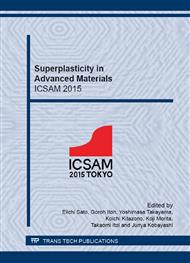[1]
K.A. Padmanabhan, G.J. Davies, Superplasticity: mechanical and structural aspects, environmental effects, fundamentals and applications. Springer-Verlag; 1980. Reference to a chapter in an edited book.
Google Scholar
[2]
K.A. Padmanabhan, R.A. Vasin, F.U. Enikeev, Superplastic Flow: Phenomenology and Mechanics, Springer; (2001).
Google Scholar
[3]
K.A. Padmanabhan, J. Schlipf, Model for grain boundary sliding and its relevance to optimal structural superplasticity Part 1 – Theory, Mater. Sci. Technol. 12 (1996) 391–9.
DOI: 10.1179/026708396790165920
Google Scholar
[4]
K.A. Padmanabhan, Grain boundary sliding controlled flow and its relevance to superplasticity in metals, alloys, ceramics and intermetallics and strain-rate dependent flow in nanostructured materials, J. Mater. Sci. 44 (2009) 2226–2238.
DOI: 10.1007/s10853-008-3076-1
Google Scholar
[5]
K.A. Padmanabhan, H. Gleiter, A mechanism for the deformation of disordered states of matter, Curr. Opin. Solid State Mater. Sci. 16 (2012) 243–253.
DOI: 10.1016/j.cossms.2012.05.001
Google Scholar
[6]
S. Sripathi, K.A. Padmanabhan, On the experimental validation of a mesoscopic grain boundary sliding-controlled flow model for structural superplasticity, J. Mater. Sci. 49 (2014) 199–210.
DOI: 10.1007/s10853-013-7693-y
Google Scholar
[7]
Y. Kawamura, T. Nakamura, A. Inoue, T. Masumoto, High-strain rate superplasticity due to newtonian viscous flow in La55Al25Ni20 Metallic Glass, Mater. Trans. JIM 40 (1999) 794–803.
DOI: 10.2320/matertrans1989.40.794
Google Scholar
[8]
K.A. Padmanabhan, A theory of structural superplasticity, Mater. Sci. Eng. 29 (1977) 1–18.
Google Scholar
[9]
A. Smolej, B Skaza, M. Fazarinc, Determination of the strain-rate sensitivity and the activation energy of deformation in the superplastic aluminium alloy, RMZ – Materials and Geoenvironment, 56 (2009) 389–399.
Google Scholar
[10]
F. Musin, R. Kaibyshev, Y. Motohashi, G. Itoh, High strain rate superplasticity in a commercial Al–Mg–Sc alloy, Scr. Mater. 50 (2004) 511–516.
DOI: 10.1016/j.scriptamat.2003.10.021
Google Scholar
[11]
T.G. Nieh, L.M. Hsiung, J. Wadsworth, R. Kaibyshev, High strain rate superplasticity in a continuously recrystallized Al–6%Mg–0. 3%Sc alloy, Acta. Mater. 46 (1998) 2789–800.
DOI: 10.1016/s1359-6454(97)00452-7
Google Scholar
[12]
S. Fernandez, M.J.Q. Hernández, J.O. García, L.F.V. González, R. González, J.V. González, Superplasticity of ultrafine grained low-alloy steels, Mem. Trab. Difus. Científica. Téc. 10 (2012) 45–56.
Google Scholar
[13]
K.A. Padmanabhan, G.J. Davies, Numerical analysis of superplasticity data for use in metal forming applications, J. Mech. Phys. Solids. 18 (1970) 261–275.
DOI: 10.1016/0022-5096(70)90007-4
Google Scholar
[14]
N. Kumar, K.S. Raman, D.H. Sastry, E.A. Little, Investigation of superplasticity by the impression creep technique, J. Mater. Sci. 25 (1990) 753–755.
DOI: 10.1007/bf00714105
Google Scholar
[15]
I. Charit, R.S. Mishra, Low temperature superplasticity in a friction-stir-processed ultrafine grained Al–Zn–Mg–Sc alloy, Acta. Mater. 53 (2005) 4211–4223.
DOI: 10.1016/j.actamat.2005.05.021
Google Scholar
[16]
S.A. Shei, T.G. Langdon, The mechanical properties of a superplastic quasi-single phase copper alloy, Acta. Metall. 26 (1978) 639–646.
DOI: 10.1016/0001-6160(78)90116-5
Google Scholar
[17]
H. Yan, R. Chen, E. Han, Superplasticity of Mg-5. 8Zn-1Y-Zr alloy sheet fabricated by combination of extrusion and hot-rolling processes, Sci. China Ser. E Technol. Sci. 52 (2009) 166–171.
DOI: 10.1007/s11431-008-0293-4
Google Scholar
[18]
W.Y. Kim, S. Hanada, T. Takasugi, Flow behavior and microstructure of Co3Ti intermetallic alloy during superplastic deformation, Acta. Mater. 46 (1998) 3593–3604.
DOI: 10.1016/s1359-6454(98)00029-9
Google Scholar
[19]
T.G. Nieh, J. Wadsworth, Microstructural characteristics and deformation properties in superplastic intermetallics, Mater. Sci. Eng. A 239–240 (1997) 88–96.
DOI: 10.1016/s0921-5093(97)00564-9
Google Scholar
[20]
H.J. Frost, M.F. Ashby, Deformation-mechanism maps: the plasticity and creep of metals and ceramics, Pergamon Press, (1982).
Google Scholar
[21]
K.A. Padmanabhan, H. Gleiter, Optimal structural superplasticity in metals and ceramics of microcrystalline- and nanocrystalline-grain sizes, Mater. Sci. Eng. A 381 (2004) 28–38.
DOI: 10.1016/j.msea.2004.02.054
Google Scholar


